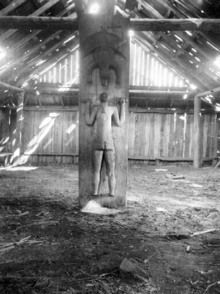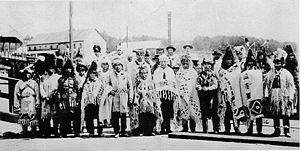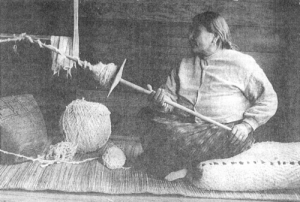
Coast Salish art
Encyclopedia

Coast Salish
Coast Salish languages are a subgroup of the Salishan language family. These languages are spoken by First Nations or Native American peoples inhabiting the territory that is now the southwest coast of British Columbia around the Strait of Georgia and Washington state around Puget Sound...
peoples. Coast Salish are peoples from the Pacific Northwest Coast made up of many different languages and cultural characteristics. Coast Salish territory covers the coast of British Columbia
British Columbia
British Columbia is the westernmost of Canada's provinces and is known for its natural beauty, as reflected in its Latin motto, Splendor sine occasu . Its name was chosen by Queen Victoria in 1858...
and Washington state. Within traditional Coast Salish art there are two major forms; the flat design and carving, and basketry and weaving. In historical times these were delineated among male and female roles in the community with men made "figurative pieces, such as sculptures and paintings that depicts crest, shamanic beings, and spirits, whereas women produced baskets and textiles, most often decorated with abstract designs."
History
The settlement of non-natives in this region was one of the first for the Pacific Northwest Coast which brought early cultural disruptions much sooner and faster than most of the coast.This made it so a limited quantity of ancient artifacts of the art form were produced, especially compared to amount that exists about other Northwest Coastal art.The Coast Salish lived in shed-roofed longhouses, large dwellings made from cedar planks and beams, with large extended families living within the house. Platforms around on the inside stood 3 or 4 feet above ground against the wall and were used as sleeping area's. Sometimes large beams on the sides of the longhouse called "House Posts" would be carved or painted depicting ancestors, family history, or supernatural beings. Some longhouses grew to enormous sizes such as one Simon Fraser
Simon Fraser (explorer)
Simon Fraser was a fur trader and an explorer who charted much of what is now the Canadian province of British Columbia. Fraser was employed by the Montreal-based North West Company. By 1805, he had been put in charge of all the company's operations west of the Rocky Mountains...
described in his visit with Sto:lo
Stó:lo
The Sto:lo , alternately written as Stó:lō, Stó:lô or Stó:lõ and historically as Staulo or Stahlo, and historically known and commonly referred to in ethnographic literature as the Fraser River Indians or Lower Fraser Salish, are a group of First Nations peoples inhabiting the Fraser Valley of...
people with a house measuring 640 feet long and 60 feet wide or another Sḵwx̱wú7mesh longhouse measuring 200 feet long by 60 feet wide where 11 families lived in the house, numbering around 100 people.
Among Coast Salish in the central region, the sxwayxwey (Sx̱wáýx̱way or Skwayskway in other languages) mask ceremony is an important part of the culture. Men from families who have the hereditary right to be initiated into the sxwayxwey society and wear the mask, and perform dance with the addition of women singers and a special song. The masks themselves have budged out cylindrical eyeballs, “horns” represented by animal heads, and drooping tongues with large feathers creating a dynamic crown. They are accompanied by special regalia covered with feathers and leggings with hoof rattles attached.


House posts, grave monuments, masks, ritual paraphernalia such as rattles, and women crafted woven robes, some plain, some elaborately coloured. Rattles made from sheets of mountain-goat horn bent and then sewn to form volumetric triangles originally adorned with strands of mountain-goat wool.
The art form is used in spindle whorls, house posts, welcome figures, combs, bent wood boxes, canoes, and other cultural objects.
Revival
Coast Salish art has undergone a revival in recent years. One person involved in the revival is Sḵwx̱wú7mesh artist Aaron Nelson-Moody. In 2005 he carved a large cedar door to be used at the BC-Canada Pavilion in the 2006 Turin Olympic Game.Cowichan artist Edward Joe, who has adapted the Coast Salish art form into fine jewelry and prints, says "(Coast) Salish art has as smooth slowing motion intended to create a calm mood. The stories, legends, and myths are depicted in many of my art pieces. Animals from the land, sea, and sky are designed in a playful manner."
On October 24, 2008, the Seattle Art Museum
Seattle Art Museum
The Seattle Art Museum is an art museum located in Seattle, Washington, USA. It maintains three major facilities: its main museum in downtown Seattle; the Seattle Asian Art Museum in Volunteer Park on Capitol Hill, and the Olympic Sculpture Park on the central Seattle waterfront, which opened on...
opened "S'abadeb—The Gifts: Pacific Coast Salish Art and Artists", a Coast Salish art exhibition from 75 works of art from national and international collections of both traditional and contemporary artists.
Characteristics
It also differs from other Northwest Coast artNorthwest Coast art
Northwest Coast art is the term commonly applied to a style of art created primarily by artists from Tlingit, Haida, Tsimshian, Kwakwaka'wakw, Nuu-chah-nulth and other First Nations and Native American tribes of the Northwest Coast of North America, from pre-European-contact times up to the...
in that it is more minimalist and straight forward. A belief in the overexposure of spirit images would weaken the spiritual powers of the beings portrayed, and as a result very few pieces were produced.
The "simplicity, antiquity, limited quantity and sometimes impenetrable iconography of (Coast) Salish art" have led to dismiss it in comparison to neighbor art forms, but Aldona Jonaitis in Art of the Northwest Coast remarks "Coast Salish art, like that of other Northwest Coast groups, responds to the social needs for which the archaic style was well suited... Coast Salish art cannot be judged according to alien values appropriate to other Northwest Coast groups, but, like most kinds of art, must be understood as visual statements meaningful and valuable to their creators."
Coast Salish artists
- Susan Point
- Chris Paull
- Dionne Paul
- Aaron Nelson-Moody
- Jody Broomfield
- Edward Joe
- Mark Gauti
- Todd Baker
Further reading
- Steven C. Brown, Rebecca Blanchard, and Nancy Davenport. Contemporary Coast Salish Art. University of Washington Press (August 2005). ISBN 978-0295984858.
- Point, Susan. Susan Point: Coast Salish artist. Douglas & McIntyre (November 2000). ISBN 978-0295980188.
- Jonaitis, Aldona. Art of the Northwest Coast. Douglas & McIntyre, 2006. ISBN 0295986360.
External links
- Coast Salish art on the RRN
- Susan Point - Musqueam artist known for doing Coast Salish art
- Photo of Lummi carver Al Charles, 1970, U.Wash Digital Collections
- UVic anthropologist “transports” Coast Salish art to the public Retrieved June 19, 2008
- Coast Salish Welcome Figures at YVR Airport Retrieved June 19, 2008.
- S'abadeb—The Gifts: Pacific Coast Salish Art and Artists - Coast Salish art show at the Seattle Art Museum.

